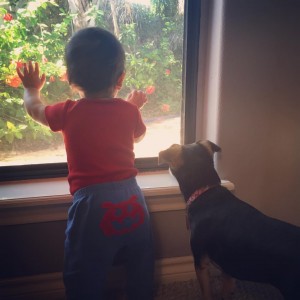Which dogs are best for families with small children? While there may be some breeds that are a better fit for your lifestyle than others, the answer to the question of kids and dogs usually isn’t about breed. The dogs who are best with children are the ones we’ve taught to behave well around kids. No less important, these are also dogs who live with kids who have learned to behave well around dogs (we’ll leave that part for another blog entry).
When to start? The best time to start training your dog for a life with children is before you have your first child. I recommend folks start about 3-4 months into their pregnancy, or about the 6-months prior to brining their child home if they are adopting. Starting early allows us to troubleshoot any problems that may arise long before we have the actual child present who will need so much of our energy and attention.
Setting goals. For most families the goal is simple: maintain a healthy and peaceful lifestyle for everyone involved (most especially the dog) as the family grows. Jennifer Shryock CDBC (familypaws.com) teaches a philosophy of inclusion, training the dog how to mind his manners around the baby while keeping him fully included in the family. The idea is to keep the dog in the room and allow him to interact appropriately in ways very similar to before the baby came.
Setting limits. Some dogs (most really) will still need time away from the baby. This is as much for the dog as it is for the rest of the family. Kids are sometimes loud and require lots of attention from the adult humans. The dog might actually appreciate getting away for a while. I recommend crate training dogs to teach them they have a safe place to settle down on their own.
We may also decide that some places in the house, like the nursery, will be off limits to the dog. Best to start teaching those limits now as well.
Many dogs will also need to brush up on their manners, especially when it comes to how they’ve become accustomed to soliciting our attention. Barking, nuzzling, or pawing at us may not be the best choice anymore when we’re holding a newborn or interacting with a toddler. And we certainly don’t want even a small dog jumping up next to the baby uninvited. It’s easy for dogs to learn appropriate ways to get our attention (like sitting politely) by reinforcing that good behavior with food, praise, petting and play. Basically, we teach it by rewarding them with – attention.
Reinforcement-based training. Expecting parents should focus on teaching simple useful skills to their dogs. Training our dog to touch and follow our hand (hand targeting) is a great start. It makes making moving our dogs and redirecting their attention very easy. Sit and lie down: very useful skills. I’m also a big fan of teaching dogs “mat training.” Whenever I put my dog’s mat down, no matter where I put it, she lies on it and remains still until given further instructions. This skill allows the dog to stay in the room with the family (see inclusion above) while also keeping still and calm. All of these skills are taught with modern reinforcement-based training (think clicker training). We should avoid training that includes fear or pain (think prong collar or shock collar). We don’t want to associate the new baby or child with anything that involves scaring or hurting the dog.
Getting ready for the new and different. In some respects, everything is about to change. There will be new skills to learn and perhaps some new limits, as we noted above. There will also be lots of new sights, sounds, and smells for our dog. We should begin introducing some of the baby’s gear (strollers, infant seats, swings and bouncers) by associating them with praise and treats. Even better, we can associate these new items with calm behavior on the mat – which itself is associated with praise and treats. We can also prepare our dog for the sounds a baby makes in the same way. Search “baby crying” on YouTube and see all the offerings that pop up. Associate that too with good behavior, praise and treats. While we’re at it, we could introduce him to the smells of baby wipes and lotions. All of this preparation will make the transition less stressful when the baby actually comes home.
Dogs with behavior challenges. Most dogs will accept a new family member with few or no issues at all. Dogs who have a history of fear, anxiety, or aggressive behavior will need extra help. Contact a dog behavior professional with the education and experience necessary helping you with these issues. The International Association of Animal Behavior Consultants is a great resource for finding a trainer or behaviorist in your area.
Michael Baugh CDBC CPDT-KSA is a dog behavior consultant specializing in aggressive behavior in dogs. He helps families prepare their dogs for new babies and other life changes in Houston, TX.

